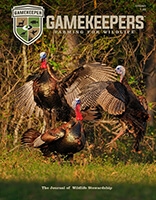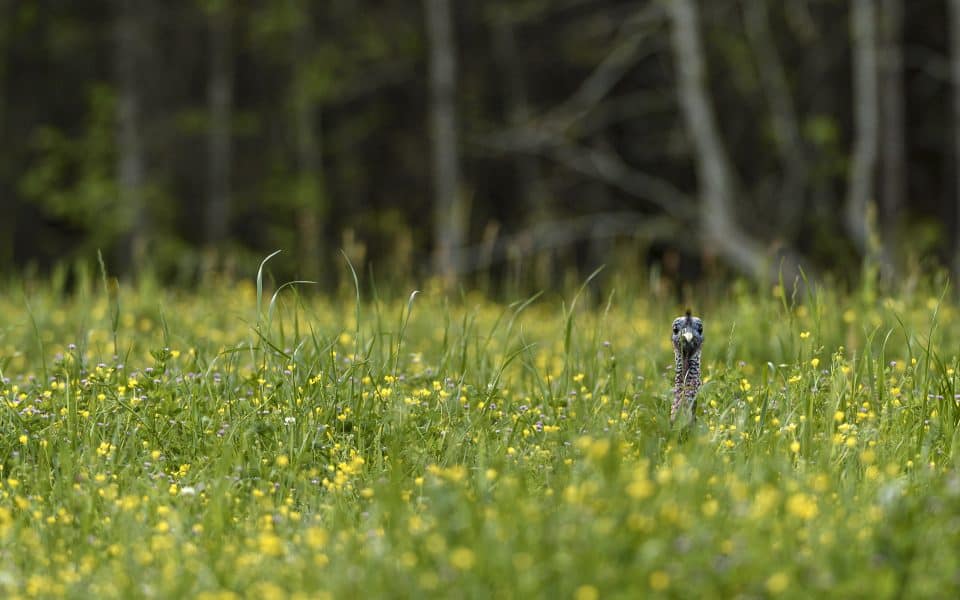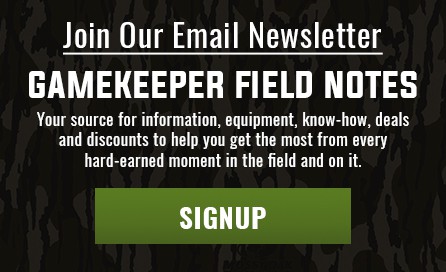A turkey hunting mentor once said that always and never only apply to turkey behavior in two ways—they roost in trees and nest on the ground. Sounds about right! With their position in the food chain, wild turkeys haven’t survived for millennia being careless and predictable. What makes turkey hunting fun and downright addictive is there are few hard and fast rules about wild turkey behavior. One aspect that fuels our passion as turkey hunters, is the challenge to “read” what a turkey may be communicating with its body language, be its mood, status, intent, or a combination thereof.
In my humble opinion, success in turkey hunting can be attributed, in large part, to dedicated scouting, calling, woodsmanship, and shooting skills. However, I believe consistently successful hunters—season after season—possess impressive observational skills and a keen eye for detail. They’re able to detect a turkey’s subtle, or not-so-subtle, body language signals and accurately assess what those signals communicate in the moment. Such skills can tip the odds in your favor—and might just mean you’re walking back to the truck about twenty pounds heavier. Or not!
This column offers examples of wild turkey body language this author has encountered in the field. Understanding what these behaviors may communicate can impact how a hunt unfolds. Likewise, veteran turkey hunter and wild turkey researcher, Dr. Michael J. Chamberlain, Ph.D., National Wild Turkey Federation Distinguished Professor at the Warnell School of Forestry and Natural Resources at the University of Georgia, shares his experiences concerning turkey body language and how they affected his hunts.
Squatting
All turkeys squat to simply rest, loaf and when dusting and preening. Other times turkeys squat to hide from danger such as when a predator is spotted or from approaching turkeys who threaten, i.e., a single tom and a jake gang. The tom in the lead photo squatted to hide from three jakes as they were passing through a clover plot. They ended up spotting him peering above the vegetation. The exposed tom made a valiant rush but was swiftly escorted out of the area.
Squatting is not uncommon in gobblers who are chilling out, catnapping during midday. Like bucks, the breeding season takes a toll on toms who sacrifice feeding time and burn extra energy displaying for hens and defending their breeding territories. Glassing with a quality set of binoculars along shady field edges on late spring afternoon hunts is a good strategy to locate a tom peeking above the vegetation watching for hens.
Dr. Chamberlain: “I was hunting out west and had a tom fly across a small river to reach my side. When he landed, he immediately knew something was wrong and although I am only speculating, I believe he saw one of my hunting partners. He quickly squatted down beside a tree on the riverbank and stayed there for quite some time before I was able to approach him and finally get close enough for a shot.”
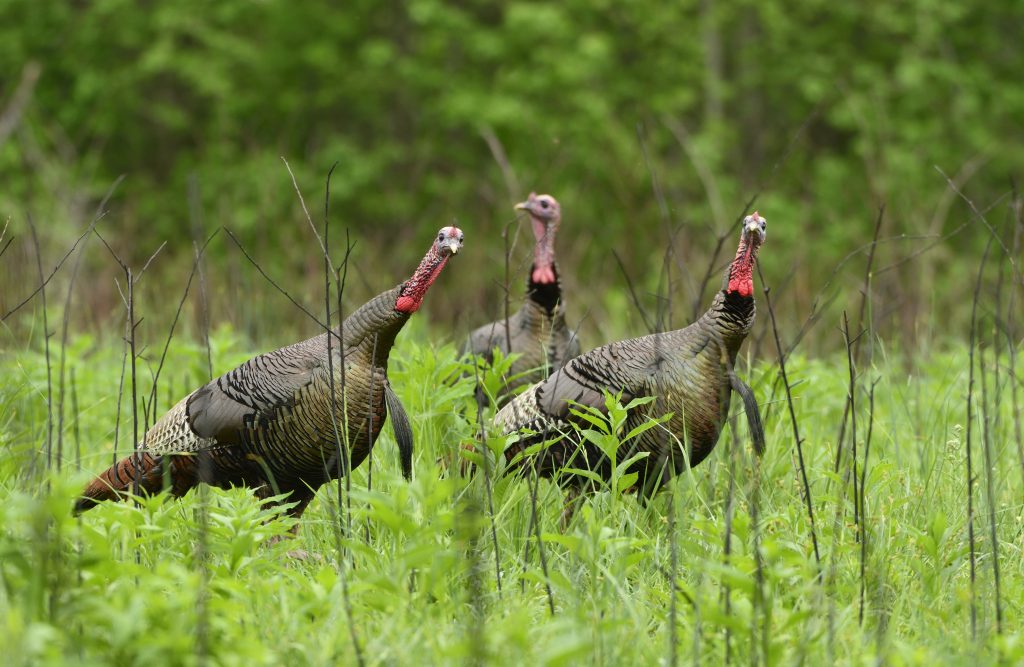
Tes Jolly
Rubbernecking
We’ve all been there, the target of a rubbernecking turkey. A slight move, odd noise or seemingly nothing at all can trigger a turkey into rubbernecking. That unmistakable, head tilting stare at the end of an outstretched neck is inescapable. Freeze, pray and avoid eye contact were the only options I had with the birds pictured in a newly regenerated burn area. A full minute passed, plenty of time to make a shot but that’s not always the case.
A rubbernecker is simply what the name implies. It’s a turkey on mild alert and not necessarily about to bolt. It’s curious, or senses something’s not quite as it should be. The head and neck are stretched forward. Each eye works independently with monocular periscopic vision swiveling to get a better look at the object of attention. The bird may move even closer to satisfy its curiosity. If it doesn’t putt, praise the Lord, the bird may settle down once it verifies there’s no threat.
Turkeys are prey creatures with a paranoid sense of survival so rubbernecking is a common daily behavior. The best example of rubbernecking I’ve witnessed is when turkeys spy a snake. They’ll spend many minutes circling and stretching their necks forward to get a better look at a snake in the grass.
Dr. Chamberlain: “I called a bird to me last season that got just out of range, and then walked into some brush where he stood and displayed a classic case of rubber necking. He stood there and picked apart everything around me, I can only surmise that he saw something that he wasn’t quite sure about. It was quite windy that day, so maybe he was just skeptical of everything around him! Either way, after a few minutes, I called very quietly to him with a couple of purrs, and he finally decided all was well.”
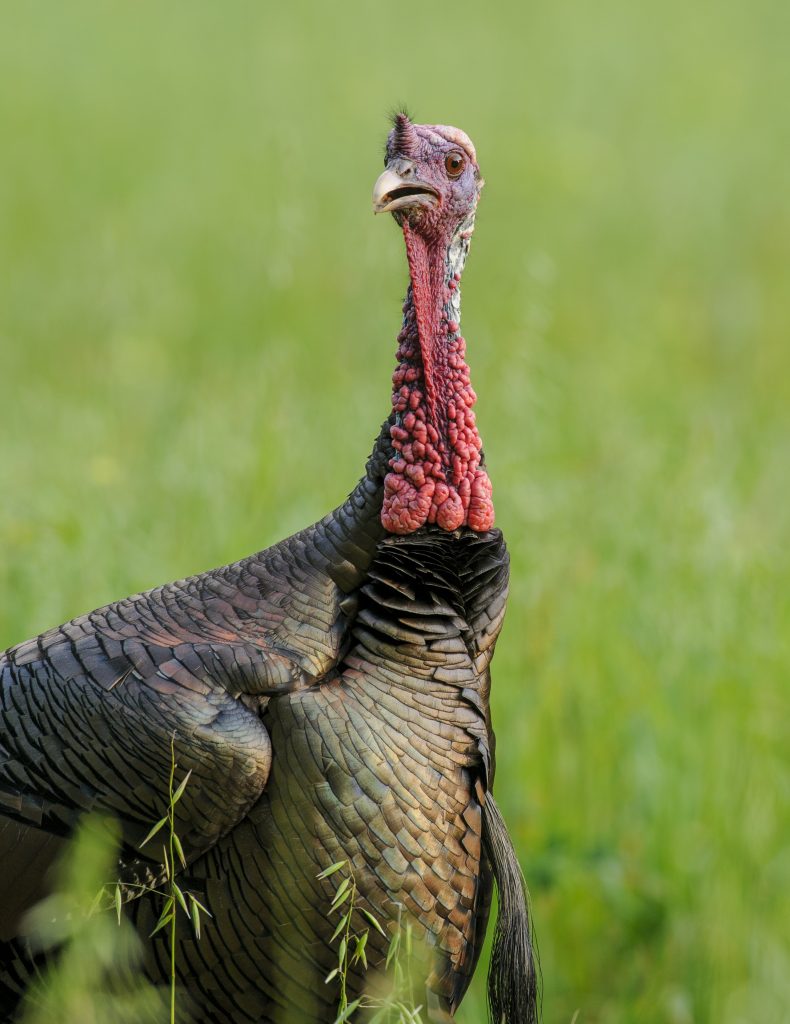
Tes Jolly
Red Alert
A tom on red alert is one whose snood suddenly contracts and its head shoots up like a submarine periscope scanning for enemies on the high seas. There have been times when a turkey has laser-locked on my position and I’d swear its X-ray stare read my mind’s deadly intentions. Those situations signaled the jig was up. The bird pictured didn’t waste time before putting space between it and danger. Some turkeys will launch airborne. If the bird isn’t zoned in on your position, follow its line of sight but avoid eye contact. It may have spotted a predator, another human or other threat. Whatever the case, if alarm putts follow, be ready to make an ethical shot if presented, or take the L along with a large helping of humble pie.
Dr. Chamberlain: “Oh yea, I have seen this WAY too many times! I’ve been blind-sided several times by birds (haven’t we all?) who suddenly went into red alert – you can almost feel them staring through you. Once that stare happens, and that head shoots up in the air, you know as a hunter that either your hunt is about to end with either a quick kill or the putt that tells you you’re headed to the truck with your tail tucked between your legs.”
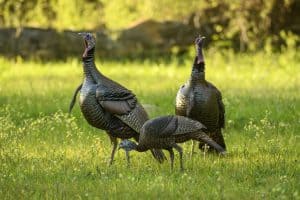
Tes Jolly
High Heading
High heading is common in late winter and early spring when hierarchies and social flocks form for the breeding period. It’s a similar pose to rubber necking yet conveys different messages. Gobblers or jakes will stand erect and motionless, with the neck extended, looking skyward as if to appear large and impressive to a hen or hens as they approach. Toms may also pose this way as a show of dominance to other toms. High heading behavior in hens signals dominance toward other hens and often precedes a battle.
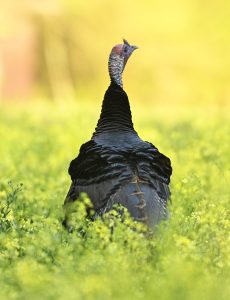
Tes Jolly
Flared Wing Butt Feathers
Notice the bird in the photo and how the wing butt feathers are flared resembling shoulder pads, making the bird appear larger and more imposing or impressive. I observe it fairly often in toms and hens in relation to high heading. This bird was addressing an oncoming pair of jakes. It’s a subtle body language signal that can alert the hunter that there are other turkeys in the area.
Wing Checks
Wing checking is simply lifting and adjusting the wings against the body. It can be a sign the turkey is moving on shortly. It doesn’t necessarily indicate high alarm but suspicious turkeys are prone to lift the wings slightly to adjust and reset them properly against the body before leaving area.
Dr. Chamberlain: “I have, unfortunately, observed this behavior a number of times when attempting to capture turkeys! I once had a hen that I had captured previously approach a rocket net with other hens that were part of her flock. Once they got to the capture site and several started consuming the bait on the ground, that hen knew something was amiss and she was super suspicious. She never putted, but she walked around adjusting her wings almost constantly, and ended up drawing several of the other hens away from the site before I could catch them.”
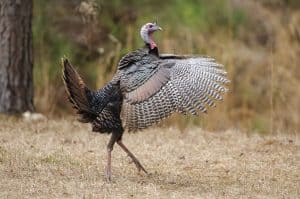
Tes Jolly
Wing Flex
The wing flex (or flap) serves several purposes. Among them it can communicate the intent to move or leave an area. The bird raises on its toes and the wings fully extend back and sweep forward and back twice. Turkeys wing flap multiple times daily which helps cast off feather debris after the bird preens. Flexing the wings after a dust bath shakes off dirt and speeds drying after a rain shower. It may signal that a bird is loosening up for the fly up to roost.
Wing flapping that follows shortly after a turkey becomes alert to possible danger is an exit signal. Be ready to make the shot. The bird is very likely to begin moving out of the area.
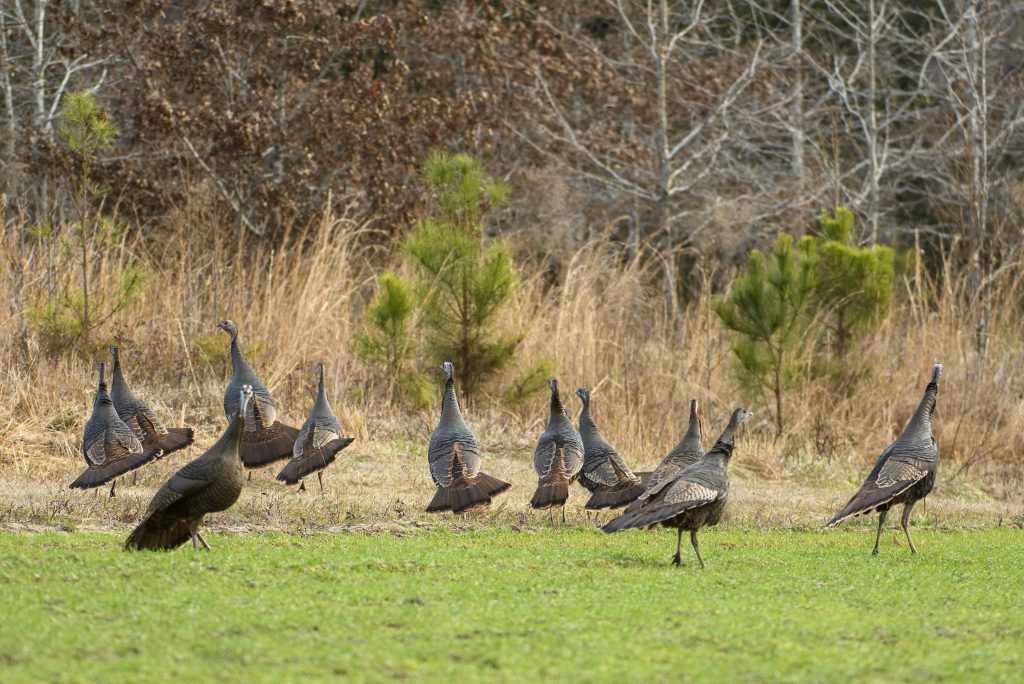
Tes Jolly
Fan Flare
The tail fan flare is often accompanied by a short, sometimes frantic dash. It can quickly spoil a hunt if it happens when birds are close. Most of my observations of fan flares happen in open areas when an avian predator such as a hawk or owl is overhead. A bird cocks its head skyward and spots danger from above. It instantly fans its tail parallel to the ground and trots quickly toward cover, head held high, and alert. Other birds that are present tend to follow the lead and immediately flare and dash in reaction to the signal. Good news is they tend not to run far but may take a few minutes to calm down.
Join our weekly newsletter or subscribe to Gamekeepers Magazine.
Your source for information, equipment, know-how, deals and discounts to help you get the most from every hard-earned moment in the field.
